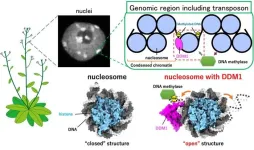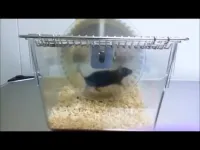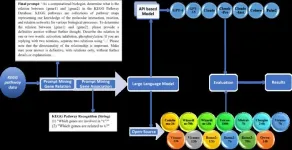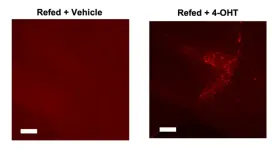(Press-News.org) PULLMAN, Wash. – A small 3-ounce sensor capable of recording 2,400 data points of movement in just one second being tested and refined by researchers at Washington State University could be key in reducing the number of injuries to racehorses.
Led by Dr. Warwick Bayly in WSU’s College of Veterinary Medicine, researchers used the biometric sensors, developed by the company StrideSAFE, to track thoroughbreds as they raced and trained at some of the top racetracks in the country. Using collected data, the team was able to identify miniscule stride changes associated with increased risk of injury, allowing intervention before a catastrophic breakdown. The researchers highlighted three horses flagged in 2023 at Churchill Downs in a case study published in the Journal of the American Veterinary Association.
“These racehorses get extensive examinations before races, but catastrophic injuries still happen, and not because they stepped in a hole or took a bad step. A large percentage have a pre-existing pathology not readily apparent on clinical examination,” said Dr. Denise Mc Sweeney, an equine surgery resident at WSU who was the first author on the study. “From our sensor data, we know most catastrophic injuries have a distinct stride pattern. Now we can see when there's something wrong with their strides and step in before a major injury occurs.”
The sensors measure changes in the rate and direction in which a horse moves its legs and body, and generate graphs of its stride pattern. The data is processed by an algorithm and compared against an “ideal stride” derived from high-performing, sound racehorses. Using data from more than 6,500 starts, the algorithm also identifies similarities with strides produced by horses that suffered catastrophic injuries. Based on how far a stride deviates from ideal and how similar it is to a stride associated with an injury, the horse is assigned an injury risk factor ranging from 1 to 5. Horses with a 5 are 950 times more likely to suffer a catastrophic injury than those with a 1, which is close to the ideal stride. Of the horses tracked, 70% have fallen into category 1, with 3.5% in category 5.
“We know there are about 1.25 catastrophic injuries per 1,000 starts, but identifying those horses before such an event occurs is like finding a needle in a haystack, as they are often subjectively sound during a pre-race examination, and many don’t show any decrease in performance,” Mc Sweeney said. “But if you can narrow it down, like the 3.5% we had out of that group, it is a lot easier to intervene and hopefully prevent injuries.”
To test and refine the algorithm, a sensor was placed on horses starting at Churchill Downs and Ellis Park in Kentucky from April 29 to July 2, 2023. Mc Sweeney was responsible for collecting clinical data on the high-risk horses.
In their case study, the team focused on a pair of 3-year-old colts and a 4-year-old stallion flagged as category 5. In each instance, the sensors alerted veterinarians and trainers to potential injury risks, prompting diagnostic imaging that confirmed an increased risk of catastrophic musculoskeletal injuries. Each horse avoided catastrophic injury after being given time to recover before returning to the track.
“These are prime examples of how this technology can prevent horses from breaking,” Mc Sweeney said. “With this information, the trainers and their vets were able to put the brakes on, and now these horses are going on to have longer careers and, hopefully, avoid a catastrophic injury.”
Mc Sweeney is hopeful the sensors will become standard for all thoroughbred racing and training.
“I believe this is going to make a huge impact,” she said. “The sensors can save the lives of horses and jockeys – they already have.”
WSU has been working with StrideSAFE since 2020 when the sensors were tested at the campus’ Hitchcock Research Racetrack. WSU is the only university in the United States with a dedicated research racetrack. From there the sensors were deployed at Emerald Downs Racetrack in Seattle and have since been used at 10 major tracks across the U.S., including Saratoga, Belmont, Keeneland and Churchill Downs.
The project was supported by a grant from the Kentucky Equine Drug Research Council. In addition to the WSU researchers, co-authors on the study include researchers Dr. Mikael Holmstrom, Kevin Donohue and David Lambert, who are employees and shareholders of StrideSafe. The WSU researchers have no vested interest in the StrideSafe company.
END
Movement sensors show promise in identifying horses at injury risk
2024-07-11
ELSE PRESS RELEASES FROM THIS DATE:
Opening the right doors: “jumping gene” control mechanisms revealed
2024-07-11
International joint research led by Akihisa Osakabe and Yoshimasa Takizawa of the University of Tokyo has clarified the molecular mechanisms in thale cresses (Arabidopsis thaliana) by which the DDM1 (Decreased in DNA Methylation 1) protein prevents the transcription of “jumping genes.” DDM1 makes “jumping genes” more accessible for transcription-suppressing chemical marks to be deposited. Because a variant of this protein exists in humans, the discovery provides insight into genetic conditions caused by such “jumping gene” mutations. The findings ...
Blood fat profiles confirm health benefits of replacing butter with high-quality plant oils
2024-07-11
Switching from a diet high in saturated animal fats to one rich in plant-based unsaturated fats affects the fat composition in the blood, which in turn influences long-term disease risk. A recent study published in Nature Medicine, conducted by a team of researchers from Chalmers University of Technology, Sweden, the German Institute of Human Nutrition, Germany and several other universities, shows that it is possible to accurately measure diet-related fat changes in the blood and directly link them to the risk of developing cardiovascular disease and type 2 diabetes.
“Our study confirms with even more certainty the health benefits of ...
Air pollution harms pollinators more than pests, study finds
2024-07-11
Bees and other beneficial bugs are disproportionately harmed by air pollution compared to crop-destroying pests, a new study published in Nature Communications has found.
Researchers from the University of Reading analysed data from 120 scientific papers to understand how 40 types of insects in 19 countries respond to air pollutants like ozone, nitrogen oxides, sulfur dioxide and particulate matter. Pollinators - including bees and some moths and butterflies - experienced a 39% decline in foraging ...
Aperiodic approximants for relating quasicrystals and modulated structures
2024-07-11
For a long time, scientists associated crystal structures with an ordered arrangement of atoms in a repeating lattice-like pattern, believing it to be the most stable configuration. However, by the 1960s, advancements in crystallography revealed materials that did not fit the traditional model. These structures exhibit a non-periodic or non-repeating pattern and are called aperiodic crystals.
There are two types of aperiodic crystals: quasicrystals (QCs), which exhibit ordered but aperiodic arrangements, and incommensurately (IC) modulated structures, where a three-dimensional periodic lattice structure ...
Hydrogen flight looks ready for take-off with new advances
2024-07-11
The possibility of hydrogen-powered flight means greater opportunities for fossil-free travel, and the technological advances to make this happen are moving fast. New studies from Chalmers University of Technology, in Sweden, show that almost all air travel within a 750-mile radius (1200 km) could be made with hydrogen-powered aircraft by 2045, and with a novel heat exchanger currently in development, this range could be even further.
“If everything falls into place, the commercialisation of hydrogen flight can go really fast now. As early as 2028, the first commercial hydrogen flights in Sweden could be in the air," says Tomas Grönstedt, Professor at Chalmers ...
Same workout, different weight loss: Signal molecule versions are key
2024-07-11
Some people lose weight slower than others after workouts, and a Kobe University research team found a reason. They studied what happens to mice that cannot produce signal molecules that respond specifically to short-term exercise and regulate the body’s energy metabolism. These mice consume less oxygen during workouts, burn less fat and are thus also more susceptible to gaining weight. Since the team found this connection also in humans, the newly gained knowledge of this mechanism might provide a pathway for treating obesity.
It is well known that exercise leads to the ...
Trained peers are as effective as clinical social workers in reducing opioid overdose, new trial finds
2024-07-11
In Rhode Island, USA, over one in four emergency department (ED) patients at high risk of overdose has a non-fatal opioid overdose in the 18 months post-discharge. A parallel, two-arm, randomized controlled trial conducted in Rhode Island of over 600 ED patients at high risk of opioid overdose found that support from a peer recovery support specialist (a trained support worker with lived experience of addiction) was as effective in reducing opioid overdose as support from a licensed clinical social worker. In other words, interviewing and intervention techniques informed by lived ...
Study: Algorithms used by universities to predict student success may be racially biased
2024-07-11
Washington, July 11, 2024—Predictive algorithms commonly used by colleges and universities to determine whether students will be successful may be racially biased against Black and Hispanic students, according to new research published today in AERA Open, a peer-reviewed journal of the American Educational Research Association. The study—conducted by Denisa Gándara (University of Texas at Austin), Hadis Anahideh (University of Illinois Chicago), Matthew Ison (Northern Illinois University), and Lorenzo Picchiarini (University of Illinois Chicago)—found ...
Comprehensive evaluation of large language models in mining gene relations and pathway knowledge
2024-07-11
Understanding complex biological pathways, such as gene-gene interactions and gene regulatory networks, is crucial for exploring disease mechanisms and advancing drug development. However, manual literature curation of these pathways cannot keep pace with the exponential growth of discoveries. Large-scale language models (LLMs) trained on extensive text corpora contain rich biological information and can be leveraged as a biological knowledge graph for pathway curation.
Recently, Quantitative Biology published a study titled "A Comprehensive ...
Researchers pinpoint brain cells that delay first bite of food
2024-07-11
LA JOLLA, CA—Do you grab a fork and take a first bite of cake, or say no and walk away? Our motivation to eat is driven by a complex web of cells in the brain that use signals from within the body, as well as sensory information about the food in front of us, to determine our behaviors. Now, Scripps Research scientists have identified a group of neurons in a small and understudied region of the brain—the parasubthalamic nucleus (PSTN)—that controls when an animal decides to take a first bite of food.
In the study, published in Molecular Psychiatry on July 4, 2024, the team of scientists set out to selectively manipulate a group of PSTN cells that dial up their ...






